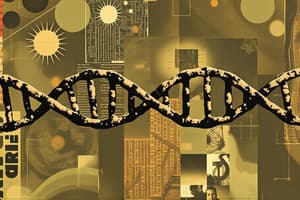Podcast
Questions and Answers
What is base pairing?
What is base pairing?
- Hydrogen bonding between adenine and thymine (correct)
- Hydrogen bonding between cytosine and guanine
- The structure of a nucleosome
- The process of DNA replication
What is a nucleotide?
What is a nucleotide?
Unit of DNA
What is a histone?
What is a histone?
Protein that binds DNA into tight coils
What is transcription?
What is transcription?
What is an intron?
What is an intron?
What is translation?
What is translation?
What is transfer RNA?
What is transfer RNA?
What is a promoter?
What is a promoter?
What is a mutation?
What is a mutation?
What is polyploid?
What is polyploid?
What is an operon?
What is an operon?
What is differentiation?
What is differentiation?
A __________ is a type of virus that infects bacteria.
A __________ is a type of virus that infects bacteria.
Eukaryotic chromosomes contain both DNA and protein, tightly packed together to form a substance called __________.
Eukaryotic chromosomes contain both DNA and protein, tightly packed together to form a substance called __________.
The duplication of DNA is called __________.
The duplication of DNA is called __________.
The principal enzyme involved in DNA replication is __________ because it joins individual nucleotides to produce a DNA molecule.
The principal enzyme involved in DNA replication is __________ because it joins individual nucleotides to produce a DNA molecule.
DNA sequences that code for proteins are called __________.
DNA sequences that code for proteins are called __________.
A __________ consists of three consecutive nucleotides that specify a single amino acid.
A __________ consists of three consecutive nucleotides that specify a single amino acid.
Gene mutations, known as __________, occur at a single point of DNA sequence.
Gene mutations, known as __________, occur at a single point of DNA sequence.
Differentiation of cells and tissues in the embryo is controlled by __________.
Differentiation of cells and tissues in the embryo is controlled by __________.
Flashcards are hidden until you start studying
Study Notes
DNA and RNA Vocabulary Review
-
Base pairing: Involves hydrogen bonds connecting adenine with thymine, essential for DNA structure.
-
Nucleotide: The fundamental unit of DNA, comprising a phosphate group, a sugar, and a nitrogenous base.
-
Histone: A protein that facilitates the winding of DNA into tight coils, playing a key role in chromatin structure and gene regulation.
-
Transcription: The process of synthesizing RNA by transcribing a specific segment of DNA, an essential step in gene expression.
-
Intron: Non-coding sequence within messenger RNA (mRNA) that is removed during RNA processing before translation.
-
Translation: The conversion of mRNA into a polypeptide chain, ultimately forming a protein.
-
Transfer RNA (tRNA): Molecular adapter that transports amino acids to the ribosome, crucial for protein synthesis.
-
Promoter: A specific DNA sequence that provides a binding site for RNA polymerase to initiate transcription, critical for gene regulation.
-
Mutation: Any alteration in the genetic material, which can impact gene function and organism traits.
-
Polyploid: A condition in which an organism has multiple sets of chromosomes, often common in plants.
-
Operon: A functional unit in prokaryotic DNA comprising a group of genes with related functions that are co-regulated.
-
Differentiation: The biological process through which cells develop specialized structures and functions, essential for multicellular organism development.
-
Bacteriophage: A type of virus that specifically targets and infects bacteria, significant in genetics and biotechnology.
-
Chromatid: The tightly packed structure formed by DNA and proteins in eukaryotic cells, especially visible during cell division.
-
Replication: The process of duplicating DNA, critical for cell division and ensuring genetic continuity.
-
DNA Polymerase: The principal enzyme responsible for synthesizing new strands of DNA by adding nucleotides during replication.
-
Exons: The coding regions of DNA that are transcribed into mRNA and translated into proteins.
-
Codon: A sequence of three nucleotides in mRNA that corresponds to a specific amino acid during protein synthesis.
-
Point mutations: Specific gene mutations that occur at a single point in the DNA sequence, potentially leading to amino acid substitutions.
-
Hox gene: A group of regulatory genes that control the differentiation of cells and tissues in the developing embryo, crucial for proper body plan development.
Studying That Suits You
Use AI to generate personalized quizzes and flashcards to suit your learning preferences.




